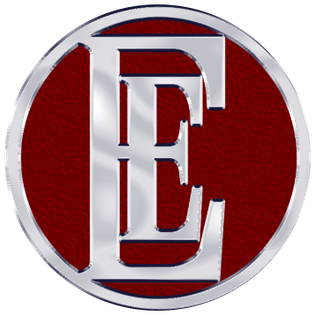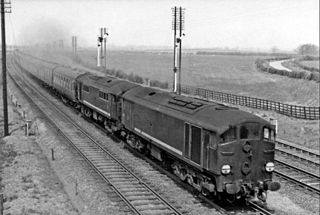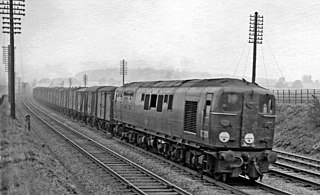
The Napier Deltic engine is a British opposed-piston valveless, supercharged uniflow scavenged, two-stroke diesel engine used in marine and locomotive applications, designed and produced by D. Napier & Son. Unusually, the cylinders were disposed in a three-bank triangle, with a crankshaft at each corner of the triangle.
D2, D02, D.II, D II or D-2 may refer to:

The English Electric Company Limited (EE) was a British industrial manufacturer formed after the armistice ending the fighting of World War I by amalgamating five businesses which, during the war, had been making munitions, armaments and aeroplanes.

The British Rail Class 55, also known as a Deltic, or English Electric Type 5, is a class of diesel locomotive built in 1961 and 1962 by English Electric for British Railways. Twenty-two locomotives were built, designed for the high-speed express passenger services on the East Coast Main Line (ECML) between Edinburgh and London King's Cross. They gained the name "Deltic" from the prototype locomotive, DP1 Deltic, which in turn was named after its Napier Deltic power units. At the time of their introduction into service in 1961, the Class 55s were the most powerful single-unit diesel locomotives in the world, with a power output of 3,300 hp (2,500 kW). They had an official maximum speed of 100 miles per hour (160 km/h), and introduced the first regular 100 mph diesel passenger service to Britain, they were however capable of higher speeds than this, and often exceeded their official maximum in service, especially in their later years, with speeds of up to 117 miles per hour (188 km/h), being recorded on level gradients, and up to 125 miles per hour (201 km/h) whilst descending Stoke Bank.

Barrow Hill Roundhouse, until 1948 known as Staveley Engine Shed, is a former Midland Railway roundhouse in Barrow Hill, near Staveley and Chesterfield, Derbyshire, now serving as a railway heritage centre.

English Electric DP1, commonly known as Deltic, is a prototype 3,300 hp (2,500 kW) demonstrator locomotive employing two Napier Deltic engines, built by English Electric in 1955.

DP2, meaning Development Prototype number 2, was a prototype Type 4 mainline diesel locomotive, built by English Electric in 1962. DP2 was effectively the prototype for the later Class 50; it trialled the engine and electronic systems later used in that class of locomotives.

The British Rail Class 28 diesel-electric locomotives, known variously as 'Metrovicks', 'Crossleys' or 'Co-Bos', were built under the Pilot Scheme for diesel locomotives as part of the British Railways 1955 Modernisation Plan.

The British Rail Class 23 were a class of ten Bo-Bo diesel-electric locomotives built by the English Electric Company (EE) in 1959. The power unit used was a Napier Deltic T9-29 9-cylinder engine of 1,100 bhp (820 kW) driving an EE generator, which powered the four traction motors. They were numbered from D5900 to D5909.
This article contains a list of jargon used to varying degrees by railfans, trainspotters, and railway employees in the United Kingdom, including nicknames for various locomotives and multiple units. Although not exhaustive, many of the entries in this list appear from time to time in specialist, rail-related publications. There may be significant regional variation in usage.

British Railways Class D16/2 was a class of prototype diesel locomotives built by British Railways at Ashford Works and introduced in 1950–1951, with a third example being introduced in 1954. They had been designed by Oliver Bulleid for the Southern Railway and were authorised in February 1947 but did not appear until after nationalisation. The diesel engine and transmission were supplied by English Electric, but the Bulleid influence was obvious. The box-like body style closely resembled Bulleid's electric locomotives and was quite different from the usual English Electric style, typified by British Rail Class D16/1 which in turn was strongly influenced by contemporary American design.
The Deltic 9000 Fund was a locomotive preservation society set up to ensure that at least one example of the British Rail Class 55 diesel locomotives was preserved following their withdrawal from service in 1981. It was placed in receivership in 2004.
Baby Deltic may refer to:

The Série 1800 was a class of 10 diesel-electric locomotives built for the Portuguese Railways (CP) in 1968. Designed and engineered by English Electric, they were closely modelled on the British Rail Class 50 locomotives but built for CP's 1,668 mmIberian gauge and larger loading gauge than possible in Great Britain.

Locomotive Services Limited is a train operating company in Great Britain. The company operates rail tours using heritage steam, diesel and electric locomotives with support from associated companies and trusts.
This page is based on this
Wikipedia article Text is available under the
CC BY-SA 4.0 license; additional terms may apply.
Images, videos and audio are available under their respective licenses.










